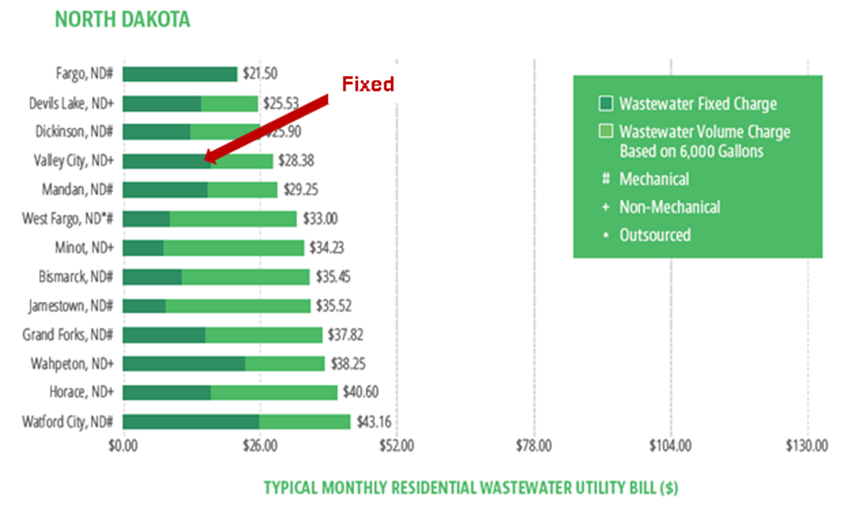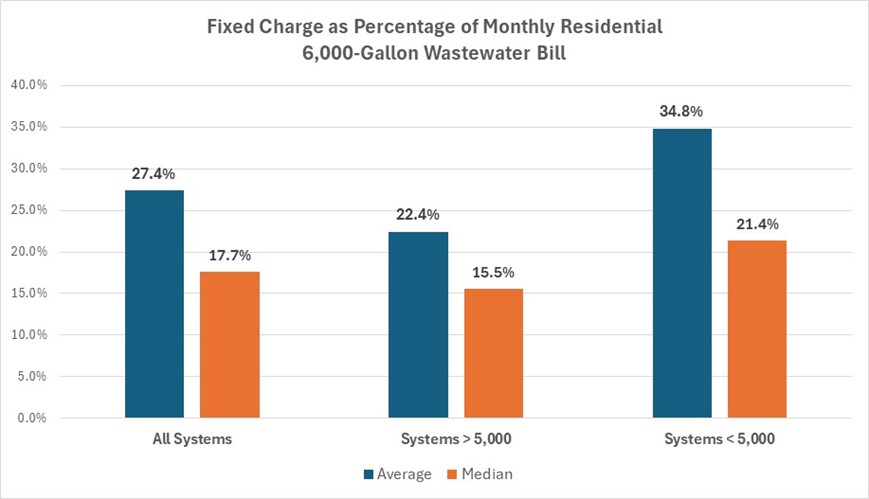One of the most useful discussions that can be facilitated by the AE2S Annual Rate Survey is related to fixed versus variable rate components. In addition to providing a visual comparison of how a monthly bill for 6,000 gallons of water or wastewater service compares to similar systems in the region or a given state, a comparison of the fixed monthly portion of the bill is also available in the data presented. The graphic below illustrates the 2024 monthly bill associated with 6,000 gallons of wastewater service for North Dakota systems serving 5,000 or more people. The darkest portion of each bar represents the fixed component of the monthly bill. In the example below, the monthly fixed charge ranges from $7.76 to $26.12, with a median value of $15.80.

Greater than 98% of all 2024 rate survey respondents reported a wastewater rate structure that included a fixed charge. Eleven percent (11%) reported a structure that only included a fixed charge, with no volumetric component. The chart below illustrates the average and median fixed charge as a percentage of the total monthly bill for 6,000 gallons as reported by 2024 rate survey respondents. It is notable that the median values are significantly lower than the average values, reflecting the fact that the monthly calculated percentage of fixed charge was less than 30% for 70% of respondents.

So how large should the fixed charge be? Should it be more than 30%? Less than 30%? What’s too large or too small? A rate structure that includes both a fixed and a variable rate component is generally the best way to balance multiple objectives such as revenue stability, equitability, and affordability. And of course, the degree to which those factors are best considered is a utility-specific discussion. Let’s briefly visit those considerations.
Revenue Stability: A rate structure consisting only of fixed monthly charges results in a steady, reliable revenue stream. This is beneficial to the utility and minimizes the potential for cash flow challenges. However, unless the structure consists of a slate of fixed charges that reflect user type and usage, such an approach can be viewed as unfair and can impose a disproportionate cost burden to low-volume users.
Equitability: An equitable rate structure is one that accounts for differences between individual needs and circumstances – such as average day and peak day demand or flow volume, or strength of wastewater discharge. As a result, a rate structure designed to assign a portion of the cost based on volume of wastewater discharged or water consumed is generally going to be considered more equitable than a fixed charge-only approach. While most annual costs to operate a water or wastewater utility are fixed, it is not necessarily fair, and almost certainly not equitable, to allocate all cost on a strictly per-account, fixed basis.
Affordability: In cases where the rate structure consists of only a fixed charge and doesn’t change to reflect different water use patterns, a customer discharging a very small quantity of wastewater or consuming a small quantity of water will pay the same as any other customer. For very small systems without a complex treatment or infrastructure network, this might be an appropriate approach and has worked well for many years for some. But several factors, such as growth, regulatory requirements, capital cost increases far outpacing inflation, and full cost pricing initiatives have significantly driven up total revenue requirements.
Operations and maintenance costs and capital costs are largely driven by usage patterns resulting from different types of users. In the case of water, the impact to capital costs from users with large seasonal peaking factors is significant. Spreading a peak day demand-driven cost on a per-account fixed basis will likely not be viewed as fair. Spreading such cost on a scaled basis associated with meter size is probably more equitable and appropriate. It is common for capital revenue requirements to trigger an affordability discussion to determine the limit at which decision makers feel the monthly charge is no longer affordable.
To balance the affordability factor with the need for a stable revenue stream, it is common practice to develop a rate structure that includes both a fixed component and a variable component. Further, when a specific user class drives the need for capital, a user class-specific approach to variable rate setting is useful and appropriate.
So, how do you determine the right fixed charge?
- Start with the cost of creating a bill each month – consideration of meter reading cost, administrative oversight and billing time, postage, etc.
- Evaluate the fixed capital component of your revenue requirements.
- Is any portion related to administrative-type functions of the utility?
- Is there a portion that can be reasonably charged per account based on how users drive capital cost in the system, such as instances in which user demands on the system are similar across and within user classes?
- Determine general utility oversight and labor costs, along with associated expenses.
Once you understand these costs, have a discussion with decision-makers regarding the balance between stable revenue, equitability, and affordability. Rate-setting discussions involve as much policy and City philosophy as the budget and cost allocations. Lastly, utilization of the comparison charts in the AE2S Rate Survey offer perspective as to how your existing or future fixed charges compare to your peers throughout the region, which can provide support and justification for proposed rate structure modifications. If you have questions, reach out to Miranda.Kleven@ae2s.com.
